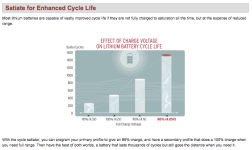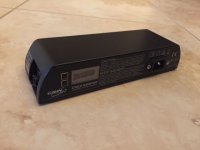As far as balance of a pack that isn't "fully charged" each time goes, that depends on the cell quality (and possibly chemistry), age, and the BMS's HVC/balance points (if it has a BMS).
My EIG NMC pack doesn't appear to (yet) have any balance issues, regardless of the SoC I check it at; though I haven't run a full-discharge test in a while. Haven't checked the cell-man A123 pack.
mlt34 said:
From what I've read, testing has shown that lowering the charging voltage significantly improves the number of cycles a cell can perform before reaching 80% of original capacity.
Well, it would have a similar effect to not charging except when needed, because it spends more time at a lower voltage.
Though, in this case it spends more time "mostly" charged, whereas what dnmun is talking about would spend more time with less charge than that, and presumably even longer cycle life.
The problem with the second method is that it's not always practical to charge only when needed, as the time of need may not be fully predictable.
In my case, I have my work schedule that gives me general predictability of when I will need at least a few Ah for the commute. So I don't in theory have to keep the pack fully charged all the time--but:
There are also times when I find out while I"m already out there I need to go a lot farther than I'd planned, and haven't time to go home and charge first. So I generally need to keep the pack on the bike fully charged for the extra range capability even though most of the time I don't need it.
But there are others that don't need the bike at any particular time, and just feel like using it sometimes, or those that never need extra range like me, but are on a predictable schedule and route, and they could probably benefit greatly from not charging it until they need it.
Another But: someone that has a small pack that tends to go out of balance when fully used, who also uses most of their capacity on a predictable run, will need to charge for a much longer time so their pack will balance, and will need to start the charging process much earlier, meanign more time at full charge. If they have to use it every dya and it takes overnight to balance, then in practice they pretty much have to keep it fully charged all the time.
So there are scenarios where not charging until it's used will work, and help extend life, and other scenarios where it's probable that the only practical way to extend life is just to not quite fully charge (lower HVC).








